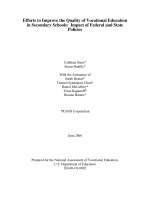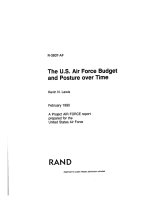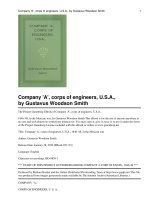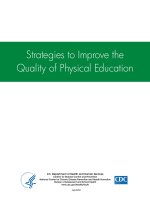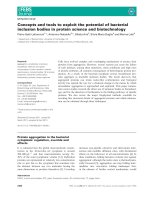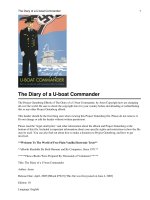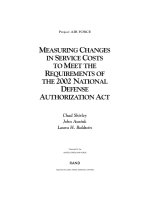Strategies to Protect the Health of Deployed U.S. Forces Force Protection and Decontamination
Bạn đang xem bản rút gọn của tài liệu. Xem và tải ngay bản đầy đủ của tài liệu tại đây (1.37 MB, 262 trang )
Strategies to
Protect the Health of
Deployed U.S. Forces
Force Protection and
Decontamination
Michael A. Wartell, Michael T. Kleinman,
Beverly M. Huey, and Laura M. Duffy, Editors
Strategies to Protect the Health of Deployed U.S. Forces:
Physical Protection and Decontamination
Division of Military Science and Technology
Commission on Engineering and Technical Systems
National Research Council
NATIONAL ACADEMY PRESS
Washington, D.C.
Copyright © National Academy of Sciences. All rights reserved.
Strategies to Protect the Health of Deployed U.S. Forces: Force Protection and Decontamination
/>NOTICE: The project that is the subject of this report was approved by the
Governing Board of the National Research Council, whose members are drawn
from the councils of the National Academy of Sciences, the National Academy of
Engineering, and the Institute of Medicine. The authors responsible for the report
were chosen for their special competencies and with regard for appropriate
balance.
This is a report of work supported by Contract DASW01-97-C-0078 between
the National Academy of Sciences and the Department of Defense. Any opinions,
findings, conclusions, or recommendations expressed in this publication are those
of the author(s) and do not necessarily reflect the view of the organizations or
agencies that provided support for the project.
International Standard Book Number 0-309-06793-6
Limited copies are available from: Additional copies are available from:
Board on Army Science and Technology National Academy Press
National Research Council, 2101 Constitution Ave., N.W.
2101 Constitution Avenue, N.W. Box 285
Washington, D.C. 20418 Washington, D.C. 20055
(202) 334-3118 800-624-6242/202-334-3313
(in the Washington metropolitan
area)
Copyright 1999 by the National Academy of Sciences. All rights reserved.
Printed in the United States of America.
Copyright © National Academy of Sciences. All rights reserved.
Strategies to Protect the Health of Deployed U.S. Forces: Force Protection and Decontamination
/>The National Academy of Sciences is a private, nonprofit, self-perpetuating soci-
ety of distinguished scholars engaged in scientific and engineering research, dedi-
cated to the furtherance of science and technology and to their use for the general
welfare. Upon the authority of the charter granted to it by the Congress in 1863,
the Academy has a mandate that requires it to advise the federal government on
scientific and technical matters. Dr. Bruce M. Alberts is president of the National
Academy of Sciences.
The National Academy of Engineering was established in 1964, under the charter
of the National Academy of Sciences, as a parallel organization of outstanding
engineers. It is autonomous in its administration and in the selection of its mem-
bers, sharing with the National Academy of Sciences the responsibility for advis-
ing the federal government. The National Academy of Engineering also sponsors
engineering programs aimed at meeting national needs, encourages education
and research, and recognizes the superior achievements of engineers. Dr. William
A. Wulf is president of the National Academy of Engineering.
The Institute of Medicine was established in 1970 by the National Academy of
Sciences to secure the services of eminent members of appropriate professions in
the examination of policy matters pertaining to the health of the public. The
Institute acts under the responsibility given to the National Academy of Sciences
by its congressional charter to be an adviser to the federal government and, upon
its own initiative, to identify issues of medical care, research, and education. Dr.
Kenneth I. Shine is president of the Institute of Medicine.
The National Research Council was organized by the National Academy of Sci-
ences in 1916 to associate the broad community of science and technology with
the Academy’s purposes of furthering knowledge and advising the federal gov-
ernment. Functioning in accordance with general policies determined by the
Academy, the Council has become the principal operating agency of both the
National Academy of Sciences and the National Academy of Engineering in pro-
viding services to the government, the public, and the scientific and engineering
communities. The Council is administered jointly by both Academies and the
Institute of Medicine. Dr. Bruce M. Alberts and Dr. William A. Wulf are chairman
and vice chairman, respectively, of the National Research Council.
National Academy of Sciences
National Academy of Engineering
Institute of Medicine
National Research Council
iii
Copyright © National Academy of Sciences. All rights reserved.
Strategies to Protect the Health of Deployed U.S. Forces: Force Protection and Decontamination
/>STRATEGIES TO PROTECT THE HEALTH OF
DEPLOYED U.S. FORCES:
FORCE PROTECTION AND DECONTAMINATION
Principal Investigators
MICHAEL T. KLEINMAN, University of California, Irvine
MICHAEL A. WARTELL, Indiana University-Purdue University Fort
Wayne
Advisory Panel
WYETT H. COLCLASURE II, Environmental Technologies Group, Inc.,
Baltimore, Maryland
STEPHEN HILL, Global Analytics, Inc., Orange, Virginia
SIDNEY A. KATZ, Rutgers University, Camden, New Jersey
FRANK K. KO, Drexel University, Philadelphia, Pennsylvania
HOWARD IRA MAIBACH, University of California, San Francisco
NAJMEDIN MESHKATI, University of Southern California, Los
Angeles
Board on Army Science and Technology Liaison
JOSEPH J. VERVIER, ENSCO, Inc., Melbourne, Florida
Staff
BRUCE A. BRAUN, Director, Division of Military Science and
Technology
BEVERLY M. HUEY, Study Director
LAURA M. DUFFY, Research Associate
PAMELA A. LEWIS, Senior Project Assistant
ANDRE MORROW, Senior Project Assistant
Department of Defense Liaisons
MICHAEL KILPATRICK, Office of the Special Assistant for Gulf War
Illnesses, Falls Church, Virginia
FRANCIS L. O’DONNELL, Office of the Special Assistant for Gulf War
Illnesses, Falls Church, Virginia
iv
Copyright © National Academy of Sciences. All rights reserved.
Strategies to Protect the Health of Deployed U.S. Forces: Force Protection and Decontamination
/>v
BOARD ON ARMY SCIENCE AND TECHNOLOGY
WILLIAM H. FORSTER, chair, Northrop Grumman Corporation,
Baltimore, Maryland
THOMAS L. MCNAUGHER, vice chair, RAND Corporation,
Washington, D.C.
ELIOT A. COHEN, School of Advanced International Studies, Johns
Hopkins University, Washington, D.C.
RICHARD A. CONWAY, Union Carbide Corporation (retired),
Charleston, West Virginia
GILBERT F. DECKER, Walt Disney Imagineering, Glendale, California
PATRICK F. FLYNN, Cummins Engine Company, Inc. Columbus, Indiana
EDWARD J. HAUG, NADS and Simulation Center, The University of
Iowa, Iowa City, Iowa
ROBERT J. HEASTON, Guidance and Control Information Analysis
Center (retired), Naperville, Illinois
ELVIN R. HEIBERG, III, Heiberg Associates, Inc., Mason Neck, Virginia
GERALD J. IAFRATE, University of Notre Dame, Notre Dame, Indiana
DONALD R. KEITH, Cypress International, Alexandria, Virginia
KATHRYN V. LOGAN, Georgia Institute of Technology, Atlanta, Georgia
JOHN E. MILLER, Oracle Corporation, Reston, Virginia
JOHN H. MOXLEY, Korn/Ferry International, Los Angeles, California
STEWART D. PERSONICK, Drexel University, Philadelphia,
Pennsylvania
MILLARD F. ROSE, NASA Marshall Space Flight Center, Huntsville,
Alabama
GEORGE T. SINGLEY, III, Hicks and Associates, Inc., McLean, Virginia
CLARENCE G. THORNTON, Army Research Laboratories (retired),
Colts Neck, New Jersey
JOHN D. VENABLES, Venables and Associates, Towson, Maryland
JOSEPH J. VERVIER, ENSCO, Inc., Melbourne, Florida
ALLEN C. WARD, Ward Synthesis, Inc., Ann Arbor, Michigan
Staff
BRUCE A. BRAUN. Director
MICHAEL A. CLARKE, Associate Director
MARGO L. FRANCESCO, Staff Associate
CHRIS JONES, Financial Associate
DEANNA SPARGER, Senior Project Assistant
Copyright © National Academy of Sciences. All rights reserved.
Strategies to Protect the Health of Deployed U.S. Forces: Force Protection and Decontamination
/>COMMISSION ON ENGINEERING AND TECHNICAL SYSTEMS
W. DALE COMPTON chair, Purdue University, West Lafayette, Indiana
ELEANOR BAUM, Cooper Union for the Advancement of Science and
Art, New York, New York
RUTH M. DAVIS, Pymatuning Group, Inc., Alexandria, Virginia
HENRY J. HATCH, (U.S. Army retired), Fluor Daniel Hanford, Inc.,
Richland, Washington
STUART L. KNOOP, Oudens and Knoop, Architects, PC, Chevy Chase,
Maryland
NANCY G. LEVESON, Massachusetts Institute of Technology,
Cambridge
CORA B. MARRETT, University of Massachusetts, Amherst
ROBERT M. NEREM, Georgia Institute of Technology, Atlanta
LAWRENCE T. PAPAY, Bechtel Technology and Consulting, San
Francisco, California
BRADFORD W. PARKINSON, Stanford University, Stanford, California
JERRY SCHUBEL, New England Aquarium, Boston, Massachusetts
BARRY M. TROST, Stanford University, Stanford, California
JAMES C. WILLIAMS, GE Aircraft Engines, Cincinnati, Ohio
RONALD W. YATES, (U.S. Air Force retired), Monument, Colorado
Staff
DOUGLAS BAUER, Executive Director
DENNIS CHAMOT, Deputy Executive Director
CAROL R. ARENBERG, Technical Editor
vi
Copyright © National Academy of Sciences. All rights reserved.
Strategies to Protect the Health of Deployed U.S. Forces: Force Protection and Decontamination
/>Preface
Chemical and biological (CB) warfare has been the subject of numer-
ous studies supported by a wide spectrum of sponsoring groups, ranging
from the military to private sector foundations. Given how much has
already been said on the subject, one might conclude that little remains on
which to comment. However, the subject is complex and controversial
enough that with each new hostile military encounter, with each potential
new threat, with each report of a possible terrorist action using CB agents,
our defensive preparedness comes under new scrutiny.
The military experience in the Gulf War, while overwhelmingly posi-
tive by almost any measure, raised some concerns. One obvious uncer-
tainty was that there might be a causal relationship between the presence
of CB agents in theater and the symptoms reported by returning military
personnel, later named the “Gulf War Syndrome.” Studies focused ini-
tially on whether personnel might have been exposed to low-level doses
of chemical agents, and if this exposure could have resulted in the re-
ported symptoms. More recent studies have been expanded to cover the
whole range of CB defense, from medical issues to materiel development
to doctrine and training.
Responding to the need for an evaluation of the military’s ability to
prosecute missions in CB environments, the Department of Defense Of-
fice of the Special Assistant for Gulf War Illnesses, through the National
Academies, sponsored a study of strategies to protect the health of de-
ployed U.S. forces, focused on CB defense. The first part of this three-year
study was divided into four parallel studies (1) to develop an analytical
framework for assessing the risks to deployed forces; (2) to review and
vii
Copyright © National Academy of Sciences. All rights reserved.
Strategies to Protect the Health of Deployed U.S. Forces: Force Protection and Decontamination
/>viii PREFACE
evaluate technologies and methods for detection and tracking exposures
to those risks; (3) to review and evaluate physical protection and decon-
tamination; and (4) to review and evaluate medical protection, health
consequences and treatment, and medical record keeping. Now, at the
end of the second year of the study, each group is providing a report to
DoD and the public on its findings and recommendations in these areas.
These four documents will be used as a basis for a new National Acad-
emies consensus committee that will prepare a synthesis report for DoD
in the third year of the project. The consensus committee will consider,
not only the topics covered in the four two-year studies, but also
overarching issues relevant to its broader charge.
This report responds to the third of the first four studies, physical
protection and decontamination. The task, which is more fully described
in the first chapter, includes (1) an assessment of DoD’s approaches and
technologies for physical protection—both individual and collective—
against CB warfare agents and decontamination of personnel and equip-
ment, and (2) an assessment of DoD’s current policies, doctrine, and train-
ing. The issues of space, budget, and staffing allocations for these
programs, although extremely important, are beyond the scope of this
report. Unlike most National Academies studies, two principal investiga-
tors conducted this study, with the assistance and guidance of an advi-
sory panel. The expertise of this advisory panel covered various topics
addressed by the study.
During the data-gathering phase, we received extensive briefings,
visited various facilities, consulted with numerous experts, solicited com-
missioned papers on specialized topics, attended many related national
conferences and symposia, and reviewed other material provided by DoD
and from the open literature. We also held one workshop to gather addi-
tional information on focussed topics. We are indebted to the organiza-
tions and individuals that gave freely of their time and talents to this
project. A special note of thanks to the individuals, listed by name, ap-
pears in Appendix F of this report. Given the countless individuals who
shared their expertise with us, there is no doubt the list is incomplete; and
we apologize for the oversights.
In responding to our Statement of Task, we attempted to cover each
aspect of the requested information, adding introductory and historical
information. No single study, however, can do justice to the entire breadth
of topics included in our study charge. Therefore, we decided to focus on
issues on which we believed we could provide especially helpful advice
to the military.
During the course of the study, we were struck by several aspects of
the CB defense community: (1) their dedication to their professions, in
general, and to CB protection, in particular; (2) the extent to which
Copyright © National Academy of Sciences. All rights reserved.
Strategies to Protect the Health of Deployed U.S. Forces: Force Protection and Decontamination
/>PREFACE ix
decades-old threat information continues to influence current require-
ments and considerations; (3) the willingness of policy makers to accept
“worst case” assessments against which to develop programs, as opposed
to developing more valid benchmarks based on more up-to-date informa-
tion; (4) the continuing need for basic science information on the chemi-
cal, physical, and toxicological properties of CB agents to facilitate the
development of modeling and simulations; (5) the need for more and
better uses of modeling and simulations; and (6) the contrast between the
high quality doctrine and training approaches available and inconsistent
CB training across services and across units.
We wish to emphasize that the CB defense community is competent,
caring, and dedicated. Although we suggest areas for improvement in
this report, we retain a strongly positive overall impression of the work of
the CB community.
The individuals who reviewed the draft report were especially im-
portant to the construction of the final report. They provided thoughtful
and constructive comments that significantly enhanced the quality of the
final report. Finally, we gratefully acknowledge the work and support of
Beverly Huey, the National Academies study director for this project. Her
dedication, intelligence, and flexibility were invaluable and are deeply
appreciated. We also thank Laura Duffy, the research associate, for her
efforts in acquiring and organizing data that were central to our analyses.
Michael T. Kleinman
Michael A. Wartell
Principal Investigators
Strategies to Protect the Health of Deployed U.S. Forces:
Physical Protection and Decontamination
Copyright © National Academy of Sciences. All rights reserved.
Strategies to Protect the Health of Deployed U.S. Forces: Force Protection and Decontamination
/>Copyright © National Academy of Sciences. All rights reserved.
Strategies to Protect the Health of Deployed U.S. Forces: Force Protection and Decontamination
/>Acknowledgments
We are appreciative of the cooperation we received from the many
individuals and organizations who provided valuable information and
guidance to us in the course of our work. First, we extend our sincere
thanks to the members of the advisory panel who provided assistance
and guidance during the information gathering process, gave thought-
provoking presentations in their respective areas of expertise, participated
in briefings from various organizations, and provided thoughtful com-
ments on the initial drafts of this report. We are also indebted to those
individuals who prepared commissioned papers for our use: William
Hinds, who wrote a paper on respiratory protection; Sidney Katz on air
contaminant removal; Frank Ko on textiles and garments for chemical
and biological protection; Howard I. Maibach and Hongbo Zhai on bar-
rier creams, percutaneous absorption, and skin decontamination tech-
niques; and Maher Todios on decontamination.
We are grateful for the guidance and support from others at the Na-
tional Academies, including Joseph Cassells and Suzanne Woolsey, who
assisted in the coordination of the four separate study efforts as they were
simultaneously being conducted; Bruce Braun, who assisted in scoping
the study, nurtured it throughout its execution and provided ongoing
oversight; and Douglas Bauer and Dennis Chamot, who adeptly dealt
with stumbling blocks when they occurred in the process and provided
thoughtful insights throughout the course of the study. We also appreci-
ate the work of Pamela Lewis who provided administrative assistance in
preparing this document for review and publication, and Carol Arenberg,
who edited this document, enhancing its clarity. Finally, we are indebted
xi
Copyright © National Academy of Sciences. All rights reserved.
Strategies to Protect the Health of Deployed U.S. Forces: Force Protection and Decontamination
/>xii ACKNOWLEDGMENTS
to numerous other NRC staff for their individual contributions: Mike
Clarke, associate division director; Margo Francesco, staff associate;
Delphine Glaze, Jacqueline Campbell-Johnson, and Andre Morrow, se-
nior project assistants; and Alvera Wilson, financial associate.
Without the extensive contributions and thought-provoking com-
ments so freely given by so many individuals throughout the course of
this study, we could not have completed the task set before us. We would
like to acknowledge those individuals who provided briefings, arranged
site visits to their organizations, gave presentations at the workshop, sup-
plied invaluable information and reports critical to our charge, answered
our searching questions very honestly, and assisted us in contacting other
sources who could provide additional information and documentation
not easily accessible. There is no doubt the list is incomplete, and we
apologize for any oversights (see Appendix F).
This report has also been reviewed by individuals chosen for their
diverse perspectives and technical expertise, in accordance with proce-
dures approved by the National Research Council’s Report Review Com-
mittee. The purpose of this independent review is to provide candid and
critical comments that will assist the authors and the National Research
Council in making the published report as sound as possible and to en-
sure that the report meets institutional standards for objectivity, evidence,
and responsiveness to the study charge. The content of the review com-
ments and draft manuscript remain confidential to protect the integrity of
the deliberative process. We wish to thank the following individuals for
their participation in the review of this report:
Robert E. Boyle, Department of the Army (retired)
Gerald T. Dinneen, Honeywell, Inc. (retired)
Stephen W. Drew, Merck & Co., Inc.
Valerie J. Gawron, Veridian Engineering
Trevor J. Little, North Carolina State University
John Nelson, NBC Defense Systems (retired)
Donald F. Petersen, Department of Defense Health Effects Programs
(retired)
Ellen Raber, Lawrence Livermore National Laboratory
William G. Reifenrath, Reifenrath Consulting & Research
Bruce O. Stuart, Schering-Plough Research Institute
While all of the advisors and reviewers listed above have provided
many constructive comments and suggestions, responsibility for the final
content of this report rests solely with the authoring principal investiga-
tors and the National Research Council.
Copyright © National Academy of Sciences. All rights reserved.
Strategies to Protect the Health of Deployed U.S. Forces: Force Protection and Decontamination
/>Contents
EXECUTIVE SUMMARY 1
1 INTRODUCTION 16
Background of the Study, 18
Charge to the National Academies, 19
Scope of the Study, 19
Limitations, 20
Approach of the Study, 21
Overview of the Report, 21
2 THREAT AND RISK ASSESSMENT 23
Historical Perspective of the Chemical/Biological
Battle Space, 23
U.S. Response, 26
Relationships among Policy; Doctrine; Research,
Development and Acquisition; and Threat, 29
Contamination Avoidance, 31
Individual Protection, 31
Collective Protection, 32
Decontamination, 32
Medical Systems, 32
Characteristics of Current and Future Chemical and
Biological Agents, 32
Effects and Tactical Utility of Chemical Agents, 32
Effects and Tactical Utility of Biological Agents, 34
xiii
Copyright © National Academy of Sciences. All rights reserved.
Strategies to Protect the Health of Deployed U.S. Forces: Force Protection and Decontamination
/>xiv CONTENTS
Proliferation of Chemical and Biological Agents, 36
Production, Weaponization, and Dispersion, 38
Threatened Use of Chemical and Biological Weapons, 39
Assessment of Chemical and Biological Warfare Risks, 39
Hazards: Routes and Levels of Exposure, 40
Threat Assessment, 52
Risk Minimization/Protection of Personnel, 53
Findings and Recommendation, 56
3 PHILOSOPHY, DOCTRINE, AND TRAINING FOR CHEMICAL
AND BIOLOGICAL WARFARE 58
Philosophy, 58
Chemical/Biological Warfare Doctrine, 60
Past Doctrine: “Fight Dirty,” 60
Current Doctrine: Contamination Avoidance, 61
Chemical/Biological Warfare Training, 61
Understanding the Risk, 63
Findings and Recommendations, 66
4 PHYSICAL PROTECTION 67
Individual Protection, 67
Risks and Challenges, 67
Current Doctrine and Training, 68
Textiles and Garments, 73
Barrier Creams, 89
Impacts on Effectiveness, 89
Patient Protective Equipment, 93
Summary, 94
Collective Protection, 94
Risks, Challenges, and Requirements, 94
Filters, 95
Filter Systems, 95
Protective Structures and Systems, 97
Advanced Filters and Adsorbents, 99
Filters, 100
Absorbers, 101
Service-Life Indicators, 102
Regeneration, 103
Catalytic Oxidation, 103
Findings and Recommendations, 104
Copyright © National Academy of Sciences. All rights reserved.
Strategies to Protect the Health of Deployed U.S. Forces: Force Protection and Decontamination
/>CONTENTS xv
5 DECONTAMINATION 108
Decontamination of Skin, 110
Risks and Challenges, 110
Technologies, 111
Decontamination of Equipment, Facilities, and Large Areas, 113
Risks and Challenges, 113
Technologies, 113
Reactions and Mechanisms, 117
Current Doctrine and Training, 132
Findings and Recommendations, 136
6 TESTING AND EVALUATION 138
Toxicological Testing, 138
Evaluation of Percutaneous Penetration, 139
Evaluation of Barrier Creams, 143
Test Equipment, 143
Predictive Models and Simulations, 149
Exercises and Systems Evaluations, 149
Findings and Recommendations, 150
7 ASSESSMENT OF MILITARY CAPABILITIES TO
PROVIDE EMERGENCY RESPONSE 151
Findings and Recommendations, 153
8 SUMMARY AND GENERAL RECOMMENDATIONS 155
Threat, 156
Policy, Doctrine, and Training, 157
Chemical/Biological Protective Equipment, 157
Threat-Based Requirements and the Development of
Equipment, 157
Physical Protection, 159
Decontamination, 160
Testing, 161
Program Objective Memorandum for Funding
Research, 162
Summary, 163
REFERENCES 164
APPENDICES
A Funding Levels 181
B Textiles and Garments for Chemical and Biological Protection 182
Copyright © National Academy of Sciences. All rights reserved.
Strategies to Protect the Health of Deployed U.S. Forces: Force Protection and Decontamination
/>xvi CONTENTS
C Evaluations of Barrier Creams 217
D Evaluating Skin Decontamination Techniques 221
E Percutaneous Absorption 224
F Contributors to This Study 230
G Biographical Sketches of Principal Investigators and
Members of the Advisory Panel 236
Copyright © National Academy of Sciences. All rights reserved.
Strategies to Protect the Health of Deployed U.S. Forces: Force Protection and Decontamination
/>Tables, Figures, and Box
TABLES
2-1 Integrated CINC Priorities, 29
2-2 Nuclear, Biological, Chemical (NBC) Nonmedical Defense
Program Priorities, 30
2-3 Categorization of Chemical Agents, 33
2-4 Categorization of Biological Agents, 35
2-5 Inhalation/Respiratory Agents, 42
2-6 Dermal Absorption Agents, 46
2-7 Dermal Necrotic Agents, 48
2-8 Inhalation/Respiratory Agents, 48
2-9 Ingestion Agents, 50
2-10 Agents Absorbed via Mucous Membranes or the Skin, 50
2-11 Arthropod Vectors, 52
2-12 Time to Achieve MOPP 4, 54
2-13 Levels of Mission-Oriented Protective Posture (MOPP), 55
3-1 Service Requirements for JSLIST, 63
4-1 Approximate Toxicity of Chemical Agents, 69
4-2 Time to Achieve MOPP 4, 71
4-3 Requirements for Chemical Protective Textiles, 74
4-4 Evolution of Performance Requirements for Protective
Textiles, 75
4-5 Summary of Required Improvements in Fibrous Material
Properties, 76
xvii
Copyright © National Academy of Sciences. All rights reserved.
Strategies to Protect the Health of Deployed U.S. Forces: Force Protection and Decontamination
/>xviii TABLES, FIGURES, AND BOX
4-6 Requirements for the C2 Air-Purification Device, 100
5-1 Differences between the Decontamination of Fixed Sites and
Mobile Forces, 109
5-2 Decontamination Coatings, 114
5-3 Characteristics of Oxidizing Decontaminants, 120
5-4 Advantages and Disadvantages of Enzymatic
Decontamination, 125
5-5 Military Air Guidelines for Chemical Warfare Agents, 135
6-1 Efficacy of Barrier Creams, 144
FIGURES
2-1 Management structure of the DoD Chemical and Biological
Defense Program, 28
3-1 Summary of appropriations for the Chemical and Biological
Defense Program, 59
4-1 Construction of a selectively permeable barrier, 77
4-2 Components of a typical current barrier system, 78
5-1 Secondary products formed by hydrolysis of sulfur
mustard, 118
5-2 Catalytic acceleration of soman by iodobenzoate, 118
5-3 Oxidation of VX in acidic solution, 122
5-4 Molecular approaches to enhancing the solubility of chemical
agents in liquid media, 123
5-5 Decontamination of paper treated with 25 mg VX
per 25 cm
2
, 126
5-6
31
P NMR study of the decontamination of O-ethyl-S-ethyl
phenyl phosphonothioate, 127
5-7 Foam decontamination of Bacillus subtilis spores after one hour
of treatment, 128
5-8 (a) High-energy accelerator fitted on a truck. (b) Schematic
drawing of large-area decontamination with ionizing
radiation, 132
BOX
2-1 Persistence of Biological Agents, 36
Copyright © National Academy of Sciences. All rights reserved.
Strategies to Protect the Health of Deployed U.S. Forces: Force Protection and Decontamination
/>Abbreviations and Acronyms
ABBREVIATIONS
2D two dimensional
3D three dimensional
cfm cubic foot per minute
CG phosgene
Cl chlorine
CK cyanogen chloride
Ct concentration × time
CX phosgene oxime
D
10
the dose level required to reduce the sample
population by a factor of 10
DS2 decontaminating solution number 2
DS2P propylene glycol monomethyl ether
ECt
50
the Ct dose that causes a defined effect (e.g.,
edema or death) in 50 percent of a given
population
GA tabun
GB sarin
GD soman
g/den gram per denier
xix
Copyright © National Academy of Sciences. All rights reserved.
Strategies to Protect the Health of Deployed U.S. Forces: Force Protection and Decontamination
/>xx ABBREVIATIONS AND ACRONYMS
H Levinstein mustard
H2S hydrogen sulfide
HD distilled mustard
HL mustard-lewisite mixture
HN nitrogen mustard
ICt
50
the Ct dose that incapacitates 50 percent of a given
population
ID
50
the dose that incapacitates 50 percent of a given
population
L Lewisite
lpm liters per minute
MeV million electron volts
m
2
/g square meter per gram
mg × min/m
3
milligram times minute per cubed meter
mm millimeter
nm nanometers
NO
x
nitrogen oxides
ppb parts per billion
Ω-kg/m
2
ohm kilogram per square meter
ACRONYMS
AERP aircrew eye/respiratory protection
ALERT attack and launch early reporting to theater
ASTM American Society for Testing and Materials
AUIB aircrew uniform integrated battlefield
BDO battle dress overgarment
BDU battle dress uniform
BWC Biological and Toxic Weapons Convention
CB chemical and/or biological
CBIRF Chemical Biological Incident Response Force
CINC commander-in-chief
CONUS continental United States
CPE collective protection equipment
CPU chemical protective undergarment
Copyright © National Academy of Sciences. All rights reserved.
Strategies to Protect the Health of Deployed U.S. Forces: Force Protection and Decontamination
/>ABBREVIATIONS AND ACRONYMS xxi
CWC Chemical Weapons Convention
DARPA Defense Advanced Research Projects Agency
DATSD (CP/CBD) Deputy Assistant to the Secretary of Defense for
Counter-proliferation and Chemical/Biological
Defense
DEPMEDS deployable medical system
DoD U.S. Department of Defense
DMMP dimethyl methylphosphate
DPD dermatopharmacodynamic
DPK dermatopharmacokinetic
ERDEC Edgewood Research, Development, and
Engineering Center (now known as the Chemical-
Biological Center of Excellence of the Soldier and
Biological Chemical Command)
FF fit factor
FM field manual
FOC functional operational capability
FR flame resistance
FY fiscal year
ICBPG improved chemical and biological protective glove
IOM Institute of Medicine
JCS Joint Chiefs of Staff
JPO-BD Joint Program Office for Biological Defense
JSAPE joint service aircrew protective ensemble
JSAM joint service aircrew mask
JSGPM joint service general purpose mask
JSIG Joint Service Integration Group
JSLIST joint service lightweight integrated suit technology
JSMG Joint Service Materiel Group
LCBPG lightweight chemical/biological protective
garment
LRC lesser regional conflicts
LSC liquid scintillation counting
MAG military air guideline
MCBAT Medical Chemical-Biological Advisory Team
MIST Man-in-Simulant Test (program)
Copyright © National Academy of Sciences. All rights reserved.
Strategies to Protect the Health of Deployed U.S. Forces: Force Protection and Decontamination
/>xxii ABBREVIATIONS AND ACRONYMS
MLRS multiple launch rocket system
MNS mission needs statement
MOPP mission-oriented protective posture
MRC major regional conflicts
MULO multipurpose rain/snow/CB overboot
MURI multidisciplinary university research initiative
NATO North Atlantic Treaty Organization
NBC nuclear, biological, chemical
NMR nuclear magnetic resonance
OOTW operations other than war
OPAA organophosphorous acid anhydrolase
OPH organophosphorous hydrolase
P3I preplanned product improvement (program)
PF protection factor
POM program objective memorandum
PPE personal protective equipment
PVC polyvinyl chloride
R&D research and development
RDA research, development and acquisition
RDIC resuscitation device individual chemical
RDT&E research, development, test and evaluation
RSDL reactive skin decontaminant lotion
SAW surface acoustic wave
SBCCOM Soldier and Biological Chemical Command
SCALP suit, contamination avoidance, liquid protection
SLS sodium lauryl sulfate
SMART-CB special medical augmentation response team–
chemical/biological
SMART-PM special medical augmentation response team–
preventative medicine
SRT Specialty Response Team
STEPO self-contained toxic environment protective outfit
TAP toxicological agent protective
TEMPER tent, expandable modular personnel
TG technical guide
VHP vapor of hydrogen peroxide
VPU vapor protective undergarment
Copyright © National Academy of Sciences. All rights reserved.
Strategies to Protect the Health of Deployed U.S. Forces: Force Protection and Decontamination
/>Strategies to
Protect the Health of
Deployed U.S. Forces
Copyright © National Academy of Sciences. All rights reserved.
Strategies to Protect the Health of Deployed U.S. Forces: Force Protection and Decontamination
/>Copyright © National Academy of Sciences. All rights reserved.
Strategies to Protect the Health of Deployed U.S. Forces: Force Protection and Decontamination
/>1
Executive Summary
Since Operation Desert Shield/Desert Storm, Gulf War veterans have
expressed concerns that medical symptoms they have experienced could
have been caused by exposures to hazardous materials or other deployment-
related factors associated with their service during the war. Potential
exposure to a broad range of chemical and/or biological (CB) and other
harmful agents was not unique to Gulf operations but have been a com-
ponent of all military operations in this century. Nevertheless, the Gulf
War deployment focused national attention on the potential, but uncer-
tain, relationship between the presence of CB agents in theater and health
symptoms reported by military personnel. Particular attention has been
given to the potential long-term health effects of low-level exposures to
CB agents.
Since the Gulf War, U.S. forces have been deployed to Haiti, Somalia,
Bosnia, Southwest Asia, and, most recently, Kosovo, where they were
(and are) at risk of exposure to toxic CB threats. The U.S. Department of
Defense (DoD) anticipates that deployments will continue in the foresee-
able future, ranging from peacekeeping missions to full-scale conflicts.
Therefore, the health and preparedness of U.S. military forces, including
their ability to detect and protect themselves against CB attack, are central
elements of overall U.S. military strength. Current doctrine requires that
the military be prepared to engage in two simultaneous major regional
conflicts while conducting peacekeeping operations and other assign-
ments around the globe. The diversity of potential missions, as well as of
potential threats, has contributed to the complexity of developing an ef-
fective strategy.
Copyright © National Academy of Sciences. All rights reserved.
Strategies to Protect the Health of Deployed U.S. Forces: Force Protection and Decontamination
/>



